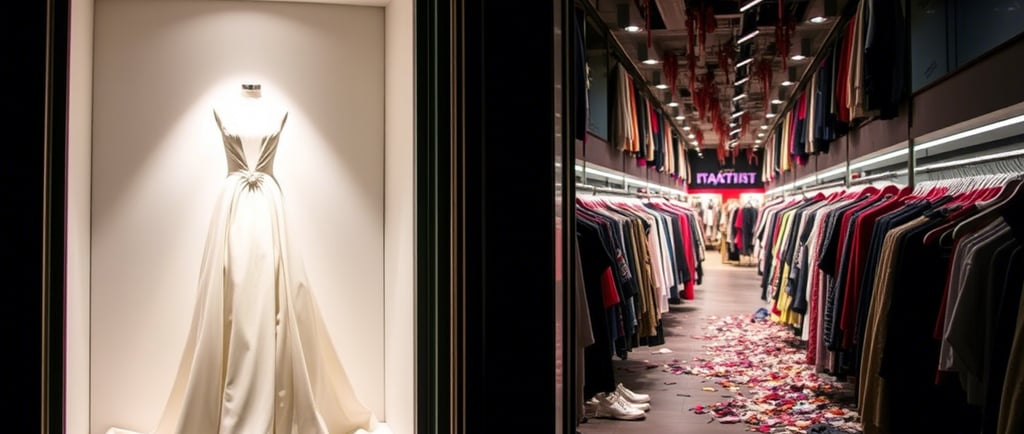Fast Fashion's Evolution: A Story of Transformation
10/17/20253 min read


The once humble clothing rack, brimming with identical garments in predictable colors, has undergone a remarkable transformation. Where mass production once reigned supreme with little regard for environmental impact or design integrity, a new narrative has emerged. Fast fashion, that revolutionary business model that brought runway designs to main street at breakneck speeds, stands at a critical inflection point—one that luxury brands are watching with strategic interest and cautious optimism.
The Rise of Disposable Fashion
In the early 2000s, retail giants revolutionized the clothing industry by compressing production cycles from months to mere weeks. Collections multiplied from four seasonal offerings to as many as 52 micro-seasons per year. The formula proved irresistible: trend-driven designs at accessible price points, refreshed with unprecedented frequency.
This model created an ecosystem where garments transformed from investments to disposable commodities. The average consumer began purchasing 60% more clothing items compared to 2000, while keeping each piece half as long. Fashion became available, but at a considerable cost that remained largely invisible to the end consumer.
The Awakening
The tide began to turn as the environmental and social consequences of fast fashion became impossible to ignore:
85% of textiles ending up in landfills annually
Fashion production contributing to 10% of global carbon emissions
Water pollution from textile dyes becoming the second largest polluter of clean water
Working conditions in production facilities facing increased scrutiny
Consumers, particularly younger demographics, started questioning the true cost behind the attractive price tags. This awakening coincided with a broader societal shift toward conscious consumption, authenticity, and transparency.
The Luxury Response
The luxury sector, initially dismissive of fast fashion as a passing trend, found itself in a unique position to offer an alternative narrative centered around craftsmanship, heritage, and sustainability. High-end brands began emphasizing:
Timeless design over transient trends
Material quality and production transparency
Artisanal craftsmanship and cultural preservation
Circular economy initiatives and repair services
Limited editions rather than mass production
This strategy allowed luxury brands to differentiate themselves not just through price point and exclusivity, but through a fundamentally different relationship with time, resources, and consumption patterns.
The Convergence
Perhaps the most fascinating development has been the convergence of these seemingly oppositional business models. Fast fashion brands have begun adopting sustainability initiatives, transparency reporting, and even recycling programs. Luxury houses have accelerated their design cycles and digital presence to maintain relevance in a faster-paced consumer landscape.
The result is a new middle ground where the boundaries between fast fashion and luxury become increasingly permeable:
Mid-tier brands embracing slow fashion principles while maintaining accessibility
Luxury brands creating diffusion lines with broader appeal
Collaborations between high-end designers and mass-market retailers
Rental and resale platforms access to luxury items
Personalized Production
Looking ahead, the most transformative force may not be either fast fashion or traditional luxury, but rather a fundamentally new approach: personalized production. Advanced manufacturing technologies, including AI-driven design, 3D printing, and on-demand production, create the possibility of garments produced only when ordered, customized to individual preferences and measurements.
This evolution would maintain the responsiveness and accessibility that made fast fashion appealing while eliminating overproduction and reducing waste. The luxury experience of personalization becomes scalable without sacrificing sustainability or quality.
Smart fabrics, digital fashion experiences, and blockchain-verified authentication further blur the lines between physical and digital ownership, potentially revolutionizing how value is perceived and created in fashion.
A New Narrative
The fast fashion revolution that began decades ago has catalyzed a complete reimagining of how clothing is designed, produced, marketed, and consumed. The industry now stands at the threshold of its next transformation—one where speed and sustainability, accessibility and quality, digital innovation and artisanal tradition might coexist rather than compete.
For luxury brands, this evolution presents both challenge and opportunity. Those who understand that consumers increasingly seek meaning, authenticity, and responsibility alongside beauty and status will find themselves not merely surviving but thriving in this new landscape.
The story of fashion continues to unfold, with each innovation writing the next chapter in an industry perpetually reinventing itself. The question is no longer whether fast fashion will disrupt luxury or vice versa, but how both sectors will adapt to a future where their defining characteristics continue to merge, diverge, and ultimately transform.
